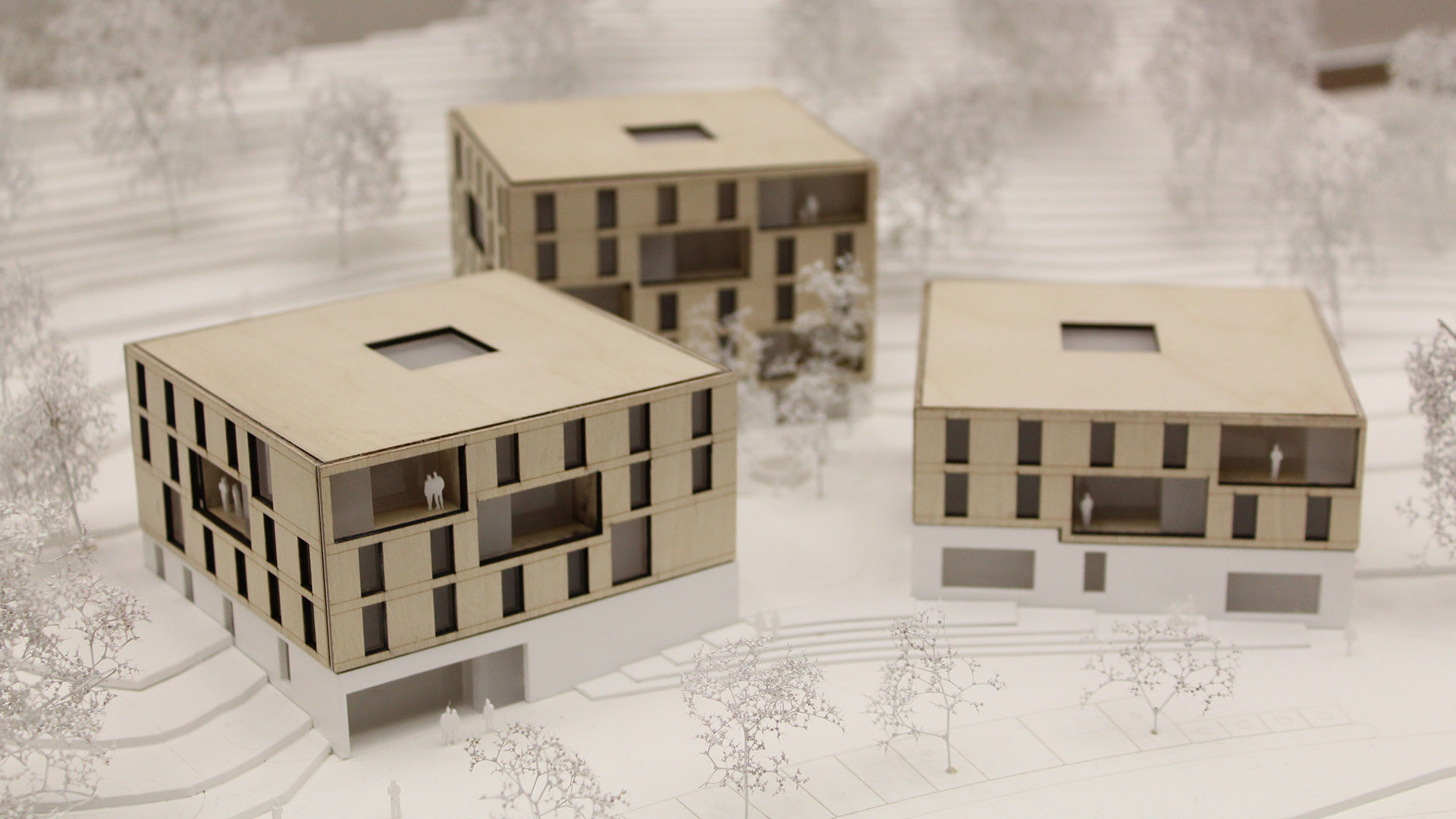Architecture with integrated practical period B.Eng.
The full-time degree program BaAP 240 ten integrates the theoretical work at the University with practical activities at an architectural office. In ten semesters (standard period of study) you will acquire 240 credit points.
Full-time foundation studies are followed by six semesters in which you alternate between studies and practical work on a semi-weekly basis.
The degree program has a modular design, structured in four self-contained stages of study. The first stage serves to provide orientation and foundation training (semesters 1-3), followed by three year-long blocks of study with integrated practical training (semesters 4 & 5, semesters 6 & 7, and semesters 8 & 9 respectively), with increasing complexity. Next you complete your bachelor's thesis full-time (semester 10), which then concludes your studies with the title of Bachelor of Engineering (B.Eng.). The Bachelor's degree program enables you to develop your own approach in a complex professional field in a responsible and well-founded manner.
Already with the first stage of BaA 240 ten, the recognized and established professional qualification of architects in Germany is attainable for you. In accordance with the laws governing architects in Germany, this leads to registration as an architect and authorization to submit building documents after two years of professional experience.
In addition, provided you are qualified, you can follow up with an in-depth two-semester Master's degree program in Residential Building. This offers you an attractive opportunity to specialize.
Degree program structure
The thorough training of your design skills forms the basis of the foundation of learning architecture. The conceptual leitmotif of the course consists of designing in alignment with constructive aspects.
In the main stage of your studies, various humanities and structural engineering disciplines will enable you to achieve a balance between theory and practice. These disciplines are accompanied by interdisciplinary projects that examine the core social issues of urbanity and the strategic management of planning and construction processes. The general and the special always confront each other. You can further deepen your interests in various elective modules.
The bachelor's degree program includes the practical project as proof of permance accompanied by the university as part of qualified and study-related practical work. Within this framework, the knowledge acquired during the studies is to be applied, deepened and adapted to practical requirements. The practical activity is intended to impart relevant knowledge, skills and experience of the professional practice specific to the degree program and to contribute to the understanding of planning, technical, economic, social and legal contexts and interactions of operational processes.
The final part of the bachelor's degree program is the bachelor's thesis, which is supplemented by a seminar. The individual students have the opportunity to prove their acquired knowledge, abilities and skills as well as their acquired key competences in the final presentation and in the colloquium.
The central program contents have a modular structure and are described in detail in the curriculum of the program. The modules are vertically and horizontally networked. The structure enables you to continuously practice design in different interrelationships. In addition to classical lectures and seminars, active work and discussion phases are also part of the training. Complex contents are discussed in group and individual discussions. The personal contact between teachers and learners is intensive.
Program Structure
| SEMESTER 1 30ECTS | SEMESTER 2 30ECTS | SEMESTER 3 30ECTS | SEMESTER 4 20ECTS | SEMESTER 5 20ECTS | SEMESTER 6 20ECTS | SEMESTER 7 20ECTS | SEMESTER 8 20ECTS | SEMESTER 9 20ECTS | SEMESTER 10 30ECTS |
|---|---|---|---|---|---|---|---|---|---|
| Design 5ECTS | Design 10ECTS | Design 5ECTS | Design 10ECTS | Impromptu 5ECTS | Design 10ECTS | Own Design 5ECTS | |||
| Construction: Load-Bearing Structures 10ECTS | Construction: Load-Bearing Structures 10ECTS | Construction: Load-Bearing Structures 10ECTS | Construction: Load-Bearing Structures 5ECTS | Construction: Load-Bearing Structures 5ECTS | Energy Concepts 5ECTS | Construction: Load-Bearing Structures 5ECTS | Construction: Load-Bearing Structures 5ECTS | Field Trip 5ECTS | |
| Building Materials 5ECTS | Building Services 5ECTS | Building Services 5ECTS | History 5ECTS | Pre-WWII Structures 5ECTS | Bachelor's Thesis 15ECTS | ||||
| History 5ECTS | History 5ECTS | Urban Planning 5ECTS | Urban Planning 5ECTS | Interior Architecture 5ECTS | |||||
| Presentation 5ECTS | Presentation 5ECTS | Presentation 5ECTS | Management 5ECTS | Practical Training 10ECTS | Management 5ECTS | Elective 2 5ECTS | |||
| Elective 1 5ECTS | Practical Training 10ECTS | Practical Training 10ECTS |
What Mainz has to offer
The Rhineland-Palatinate capital Mainz am Rhein is strongly influenced by the students of Mainz University of Applied Sciences and Johannes Gutenberg University. The beautiful location overlooking the river, the historic old town, original pubs, small shops run by the local owners, trendy pubs, theaters and museums enliven the downtown area and contribute to the daily life of students. At the same time, numerous architectural offices in Mainz and the Rhine-Main region enable you to complete various internships and later an easy start to your career.
It is the combination of economic power, landscape diversity and a rich cultural scene that makes the Rhine-Main region particularly attractive for many people. Its central and convenient location is just as interesting for companies as it is for creative artists and students.
It is the combination of economic power, landscape diversity and a rich cultural scene that makes the Rhine-Main region particularly attractive for many people. Its central and convenient location is just as interesting for companies as it is for creative artists and students.
